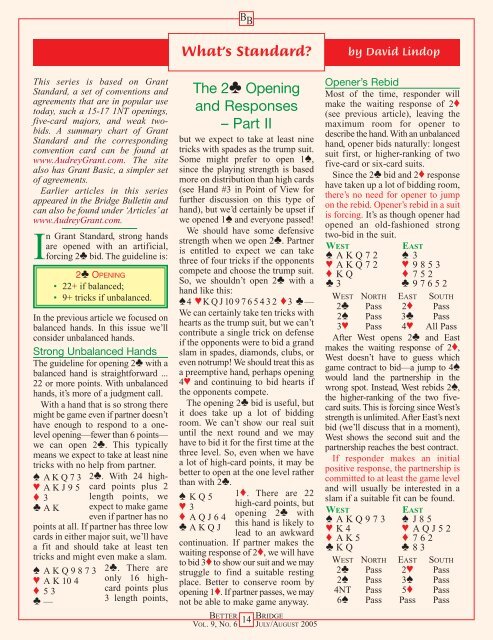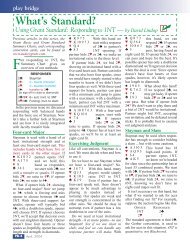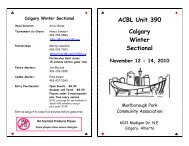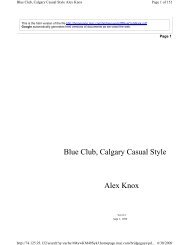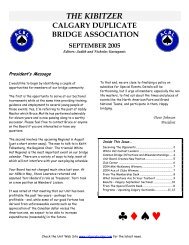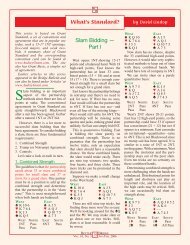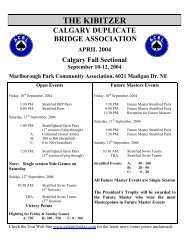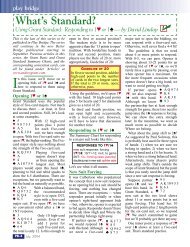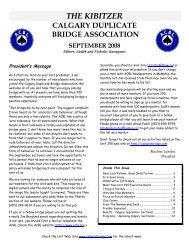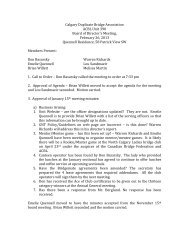What's Standard? The 2 Opening and Responses ... - Better Bridge
What's Standard? The 2 Opening and Responses ... - Better Bridge
What's Standard? The 2 Opening and Responses ... - Better Bridge
Create successful ePaper yourself
Turn your PDF publications into a flip-book with our unique Google optimized e-Paper software.
B BWhat’s <strong>St<strong>and</strong>ard</strong>?by David LindopThis series is based on Grant<strong>St<strong>and</strong>ard</strong>, a set of conventions <strong>and</strong>agreements that are in popular usetoday, such a 15-17 1NT openings,five-card majors, <strong>and</strong> weak twobids.A summary chart of Grant<strong>St<strong>and</strong>ard</strong> <strong>and</strong> the correspondingconvention card can be found atwww.AudreyGrant.com. <strong>The</strong> sitealso has Grant Basic, a simpler setof agreements.Earlier articles in this seriesappeared in the <strong>Bridge</strong> Bulletin <strong>and</strong>can also be found under ‘Articles’ atwww.AudreyGrant.com.In Grant <strong>St<strong>and</strong>ard</strong>, strong h<strong>and</strong>sare opened with an artificial,forcing 2♣ bid. <strong>The</strong> guideline is:2♣ OPENING• 22+ if balanced;• 9+ tricks if unbalanced.In the previous article we focused onbalanced h<strong>and</strong>s. In this issue we’llconsider unbalanced h<strong>and</strong>s.Strong Unbalanced H<strong>and</strong>s<strong>The</strong> guideline for opening 2♣ with abalanced h<strong>and</strong> is straightforward ...22 or more points. With unbalancedh<strong>and</strong>s, it’s more of a judgment call.With a h<strong>and</strong> that is so strong theremight be game even if partner doesn’thave enough to respond to a onelevelopening—fewer than 6 points—we can open 2♣. This typicallymeans we expect to take at least ninetricks with no help from partner.♠ A K Q 7 3♥ AKJ 9 5♦ 3♣ AK2♣. With 24 highcardpoints plus 2length points, weexpect to make gameeven if partner has nopoints at all. If partner has three lowcards in either major suit, we’ll havea fit <strong>and</strong> should take at least tentricks <strong>and</strong> might even make a slam.♠ A K Q 9 8 7 3♥ A K 10 4♦ 5 3♣ —2♣. <strong>The</strong>re areonly 16 highcardpoints plus3 length points,<strong>The</strong> 2♣ <strong>Opening</strong><strong>and</strong> <strong>Responses</strong>– Part IIbut we expect to take at least ninetricks with spades as the trump suit.Some might prefer to open 1♠,since the playing strength is basedmore on distribution than high cards(see H<strong>and</strong> #3 in Point of View forfurther discussion on this type ofh<strong>and</strong>), but we’d certainly be upset ifwe opened 1♠ <strong>and</strong> everyone passed!We should have some defensivestrength when we open 2♣. Partneris entitled to expect we can takethree of four tricks if the opponentscompete <strong>and</strong> choose the trump suit.So, we shouldn’t open 2♣ with ah<strong>and</strong> like this:♠4 ♥K Q J 10 9 7 6 5 4 3 2 ♦3 ♣—We can certainly take ten tricks withhearts as the trump suit, but we can’tcontribute a single trick on defenseif the opponents were to bid a gr<strong>and</strong>slam in spades, diamonds, clubs, oreven notrump! We should treat this asa preemptive h<strong>and</strong>, perhaps opening4♥ <strong>and</strong> continuing to bid hearts ifthe opponents compete.<strong>The</strong> opening 2♣ bid is useful, butit does take up a lot of biddingroom. We can’t show our real suituntil the next round <strong>and</strong> we mayhave to bid it for the first time at thethree level. So, even when we havea lot of high-card points, it may bebetter to open at the one level ratherthan with 2♣.1♦. <strong>The</strong>re are 22♠ KQ 5♥ 3♦ AQJ 6 4♣ AKQ JBETTERVOL. 9, NO. 6high-card points, butopening 2♣ withthis h<strong>and</strong> is likely tolead to an awkwardcontinuation. If partner makes thewaiting response of 2♦, we will haveto bid 3♦ to show our suit <strong>and</strong> we maystruggle to find a suitable restingplace. <strong>Better</strong> to conserve room byopening 1♦. If partner passes, we maynot be able to make game anyway.14BRIDGEJULY/AUGUST 2005Opener’s RebidMost of the time, responder willmake the waiting response of 2♦(see previous article), leaving themaximum room for opener todescribe the h<strong>and</strong>. With an unbalancedh<strong>and</strong>, opener bids naturally: longestsuit first, or higher-ranking of twofive-card or six-card suits.Since the 2♣ bid <strong>and</strong> 2♦ responsehave taken up a lot of bidding room,there’s no need for opener to jumpon the rebid. Opener’s rebid in a suitis forcing. It’s as though opener hadopened an old-fashioned strongtwo-bid in the suit.WESTEAST♠ A K Q 7 2 ♠ 3♥ A K Q 7 2 ♥ 9 8 5 3♦ KQ ♦ 7 5 2♣ 3 ♣ 9 7 6 5 2WEST NORTH EAST SOUTH2♣ Pass 2♦ Pass2♠ Pass 3♣ Pass3♥ Pass 4♥ All PassAfter West opens 2♣ <strong>and</strong> Eastmakes the waiting response of 2♦,West doesn’t have to guess whichgame contract to bid—a jump to 4♠would l<strong>and</strong> the partnership in thewrong spot. Instead, West rebids 2♠,the higher-ranking of the two fivecardsuits. This is forcing since West’sstrength is unlimited. After East’s nextbid (we’ll discuss that in a moment),West shows the second suit <strong>and</strong> thepartnership reaches the best contract.If responder makes an initialpositive response, the partnership iscommitted to at least the game level<strong>and</strong> will usually be interested in aslam if a suitable fit can be found.WESTEAST♠ A K Q 9 7 3 ♠ J 8 5♥ K4 ♥ AQJ 5 2♦ AK5 ♦ 7 6 2♣ KQ ♣ 8 3WEST NORTH EAST SOUTH2♣ Pass 2♥ Pass2♠ Pass 3♠ Pass4NT Pass 5♦ Pass6♠ Pass Pass Pass
With 8 high-card points <strong>and</strong> agood five-card suit, East makes apositive response of 2♥ over the 2♣bid. West shows the spade suit <strong>and</strong>East raises. East doesn’t need tojump since the partnership is committedto at least game.Having found a fit, opener usesthe Blackwood convention to checkfor aces <strong>and</strong> then bids the slam.West knows partner will have agood heart suit for the positiveresponse, so there should be a wayto dispose of the diamond loser.Even if East didn’t hold the ♥Q,West could likely establish an extrawinner in the heart suit.Responder’s RebidMost of the time, the initialresponse to 2♣ is 2♦, an artificialwaiting bid. That leaves plenty ofroom for opener to bid a suit withan unbalanced h<strong>and</strong>, but nowresponder must bid again sinceopener’s rebid is forcing.At this point, responder needs away to show a very weak h<strong>and</strong>. Thisused to be done by bidding notrumpat the cheapest available level. <strong>The</strong>problem with that approach is thatresponder would then be declarer ifthe partnership played in a notrumpcontract <strong>and</strong> the strong h<strong>and</strong> wouldbe exposed as the dummy.To avoid this, it’s become popularto agree responder’s cheapest bid in aminor suit at the three level shows aweak h<strong>and</strong>—no ace, no king, <strong>and</strong>fewer than two queens. This issometimes referred to as “cheaperminor second negative.” That’s a bitof a misnomer since the initial 2♦response is waiting, not negative.<strong>The</strong>re is no “cheapest minor”available at the three level whenopener rebids 3♦, so 3NT has to beused as the weak bid. That avoidsgetting the partnership beyond 3NT incase that’s the last makeable contract.It’s a slight flaw in this approach,but something that most players arewilling to go along with to avoidmore complex methods. <strong>The</strong> chartat the top of the next column showsall the negative rebids.BETTERVOL. 9, NO. 6B BRESPONDER’S NEGATIVE REBIDAfter responder has made a 2♦waiting response, the underlinedrebid by responder is artificial,showing a very weak h<strong>and</strong>:WESTOPENER2♣2♥OPENER♠ K 2 ♠ 6 4 3♥ AK ♥ J 7 5 3♦ K 3 ♦ 8 7 4♣ A K Q 9 7 4 2 ♣ 10 6 5WEST NORTH EAST SOUTH2♣ Pass 2♦ Pass3♣ Pass 3♦ Pass3NT Pass Pass PassAfter the artificial 2♣ opening bid<strong>and</strong> the artificial 2♦ waitingresponse, West’s 3♣ rebid is the firstnatural bid, showing clubs. It’sforcing, so East has to bid again.With a weak h<strong>and</strong>, East bids thecheapest available minor at the threelevel, 3♦, another artificial bid. Thatallows West to bid 3NT from thebest side since both the ♠K <strong>and</strong> ♦Kare protected. Whatever North leads,West has at least nine tricks.WEST2♣2♠OPENER2♣3♣OPENER2♣3♦WEST NORTH EAST SOUTH2♣ Pass 2♦ Pass2♠ Pass 3♥ Pass4♥ Pass Pass PassWest opens 2♣ <strong>and</strong> East doesn’thave enough strength or a goodenough suit for a positive response.So East makes the waiting responseof 2♦. West now shows the spadesuit <strong>and</strong> East can show the heart suit.15RESPONDER2♦3♣RESPONDER2♦3♣RESPONDER2♦3♦RESPONDER2♦3NTEASTEAST♠ A K Q 9 8 2 ♠ 4♥ A 10 3 ♥ Q J 7 5 2♦ Q 2 ♦ 7 6 3♣ AK ♣ Q 9 5 2BRIDGEJULY/AUGUST 2005West knows East has at least a fivecardheart suit <strong>and</strong> some valuessince East didn’t make the negativerebid of 3♣. West can raise to game.West knows slam is unlikely sinceEast didn’t make an initial positiveresponse in hearts. <strong>The</strong> partnershipl<strong>and</strong>s in the best contract.Opener’s Third BidAfter opener’s rebid in a suit, thepartnership is committed to gameunless responder makes a negativerebid. Even if responder makes anegative rebid, any new suit byopener below game is forcing. <strong>The</strong>only time responder can pass belowgame after making a negative rebidis if opener rebids the same suit.WESTEAST♠ A K J 10 8 4 ♠ 9 3♥ A K Q 4 ♥ 8 2♦ 4 ♦ 8 7 6 3 2♣ AQ ♣ 9 6 5 2WEST NORTH EAST SOUTH2♣ Pass 2♦ Pass2♠ Pass 3♣ Pass3♥ Pass 3♠ Pass4♠ Pass Pass PassAfter West shows the strong twobidin spades, East makes a negativerebid of 3♣. West’s 3♥ bid, a new suit,is forcing, so East gives preferenceto spades <strong>and</strong> West bids game. Evenopposite East’s terrible h<strong>and</strong>, 4♠ hasa good chance. West can trump aheart loser in dummy.WESTEAST♠ AKQ ♠ 9 6 4 2♥ A K 10 9 7 6 ♥ 5 2♦ KQ ♦ 9 7 4 3♣ 8 3 ♣ J 7 6WEST NORTH EAST SOUTH2♣ Pass 2♦ Pass2♥ Pass 3♣ Pass3♥ Pass Pass PassEast makes the waiting responseof 2♦ <strong>and</strong> West bids 2♥, forcing.East makes the artificial negativerebid of 3♣ <strong>and</strong> West, with a minimum2♣ opening, simply rebids themajor suit. With no semblance ofhelp, East settles for partscore.❧ ❧ ❧ ❧ ❧In the next issue, we’ll look atanother option for responder <strong>and</strong>more sample auctions after 2♣.


